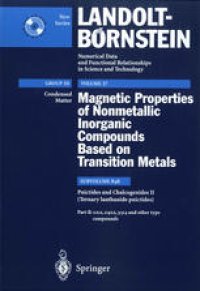
Ebook: Pnictides and Chalcogenides II (Ternary Lanthanide Pnictides). Part b: 1:2:2, 1:4:12, 3:3:4 and Other Type Compounds
- Tags: Landolt-Börnstein, Electromagnetism Optics and Lasers
- Series: Landolt-Börnstein - Group III Condensed Matter 27B4b : Condensed Matter
- Year: 2003
- Publisher: Springer-Verlag Berlin Heidelberg
- Edition: 1
- Language: English
- pdf
The magnetic properties of lanthanide (Ln) pnictides and chalcogenides have been compiled in subvolume 27B. Subvolumes 27B1, 27B2 and 27B3 (already published) deal with Ln monopnictides, monochalcogenides and binary polypnictides and polychalcogenides, respectively.
Subvolume 27B4 is devoted to the ternary Ln pnictides which together with chalcogenides are intensively studied due to fundamental importance resulting from the f-d interaction and hybridisation. The first part 4a deals with ternary 1:1:1 and 1:1:2 type compounds, while the present second part 4b will cover the types 1:2:2, 1:4:12, 3:3:4 and compounds with even more complex formulae. More over their properties related to heavy fermions, non-Fermi liquid state, spin fluctuations, etc., and the possible application of these compounds as magnetic, thermoelectric or superconducting materials are of importance.
The magnetic properties of lanthanide (Ln) pnictides and chalcogenides have been compiled in subvolume 27B. Subvolumes 27B1, 27B2 and 27B3 (already published) deal with Ln monopnictides, monochalcogenides and binary polypnictides and polychalcogenides, respectively.
Subvolume 27B4 is devoted to the ternary Ln pnictides which together with chalcogenides are intensively studied due to fundamental importance resulting from the f-d interaction and hybridisation. The first part 4a deals with ternary 1:1:1 and 1:1:2 type compounds, while the present second part 4b will cover the types 1:2:2, 1:4:12, 3:3:4 and compounds with even more complex formulae. More over their properties related to heavy fermions, non-Fermi liquid state, spin fluctuations, etc., and the possible application of these compounds as magnetic, thermoelectric or superconducting materials are of importance.